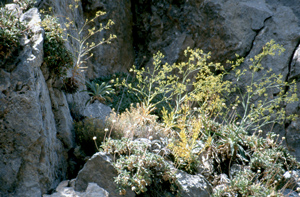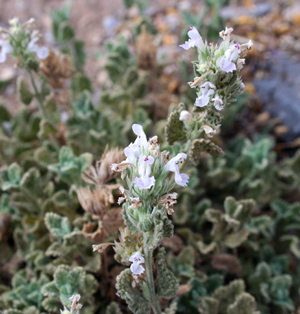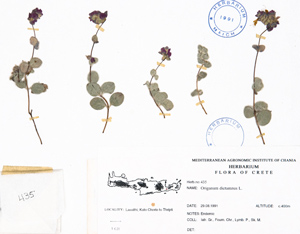Crete - Island characteristics overview

Bupleurum kakiskalae

Nepeta sphaciotica

Origanum dictamnus
-Greuter.jpg)
Anthemis glaberrima
Crete is the fifth largest island in the Mediterranean Basin and is located in the southernmost part of Greece. It has a maximum length of about 250 km, 56 km maximum width and total area of 8,700 km2 including 200 small islands and islets around it. The island is generally characterized as mountainous as the entire length is dominated by four mountain ranges: the 'White Mountains' (2,453m a.s.l.), 'Psiloritis' (2,456m a.s.l.), the 'Dikti' (2,148m a.s.l.) and 'Mount Thripti' (1,476m a.s.l.) (from west to east). The proximity of the high mountains to the sea is characterized by large deep gorges, accommodating unique habitats.
According to the latest update (Turland & Chilton, 2008), the flora of Crete comprises 1,742 native species representing 623 genera and 128 families. Additionally, 140 species are naturalized or possibly naturalized species and 81 are Doubtfully Present Species. The floristic region of Crete - Karpathos is the most important center of endemism in Greece since according to recent data it is characterized by the highest rate of endemism. According to Georghiou & Delipetrou (2010), the number of Greek endemic taxa is 1,442. More than 25% of these are located in the Crete - Karpathos region, and 258 (17.9%) are only located in the Crete – Karpathos region.
Habitats rich in endemic species in Crete (Phitos et al. 1995, Kypriotakis 1998) are the cliffs, gorges and areas of high altitude above 1,500m a.s.l.. However, the habitats in the gorges are more stable and not currently receiving intense pressure from human activities (Fielding & Turland 2005). The dominant habitat in high altitude areas is 'Endemic oro-Mediterranean heaths with gorse' (Natura 2000 Habitat code 4090), which occupies 3.52% of the area of the island (Sarris et al. 2006). Since the habitat is home to many endemic species, it has been included to a large extent in the areas of the Natura 2000 network in Crete (Sarris et al. 2006, Dafis et al. 1997) and is subject to special protection measures. In addition, many of these plants have been studied and protected though EEC financial instruments (mainly LIFE and Interreg projects).
In areas that are not characterized as rich in endemic plant species, such as lowland and upland areas, intensive agriculture has expanded, especially the cultivation of olive trees and greenhouse crops, thereby increasing the use of herbicides, pesticides and fertilizers and abandoning traditional terracing. Moreover, there is a reduction of plant diversity in these areas due to the spread of exotic invasive species (e.g., Oxalis pes-caprae) which tend to dominate at the expense of native flora. Finally, in recent years herbicides are also used in order to control vegetation at roadsides, public areas, etc., as part of preventive measures of the local municipalities against wild fires. Thus, a rapid loss of biodiversity is observed and this is particularly noticeable in the Northern areas of the island where there is intense land development mainly because of tourism. Another problem noted is the recent introduction of exotic material, mainly ornamental, aromatic and medicinal plants from neighbouring Mediterranean countries, especially from Italy. Thus, natural populations of native species are at risk due to genetic contamination.
The main sources for the conservation status of the Cretan plants are the first Red Data Book of Rare and Threatened Plants of Greece (Phitos et al., 1995), the IUCN-WCMC database (IUCN-WCMC, 1997) and the second Red Data Book of Rare and Threatened Plants of Greece (Phitos et al., 2009). According to the Red Data Books, 110 plant taxa of Crete are considered threatened at national level. According to IUCN-WCMC, Crete has the greatest percentage of “globally threatened plant taxa” (11% or 193 taxa) compared to the other Mediterranean islands, whereas an additional 238 taxa of Crete are characterized as “locally threatened” taxa (Delanoë et al., 1996).
In Crete, many wild herbs have been traditionally harvested by local people and used fresh in salads or cooked. Aromatic plants are mainly used as spices, while medicinal plants are used as traditional medicines. Various wild plants are also used as beekeeping plants. However, the balance between traditional use and biodiversity, which used to be an essential component of everyday life in Crete, is now rapidly modified: biodiversity is threatened, and people, particularly those engaged in traditional or organic farming and beekeeping, have started to realize the immediate effect of this biodiversity loss.
References
Red Data Book of Rare and Threatened Plants of Greece (Phitos et al., 1995).
Red Data Book of Rare and Threatened Plants of Greece (Phitos et al., 2009).



